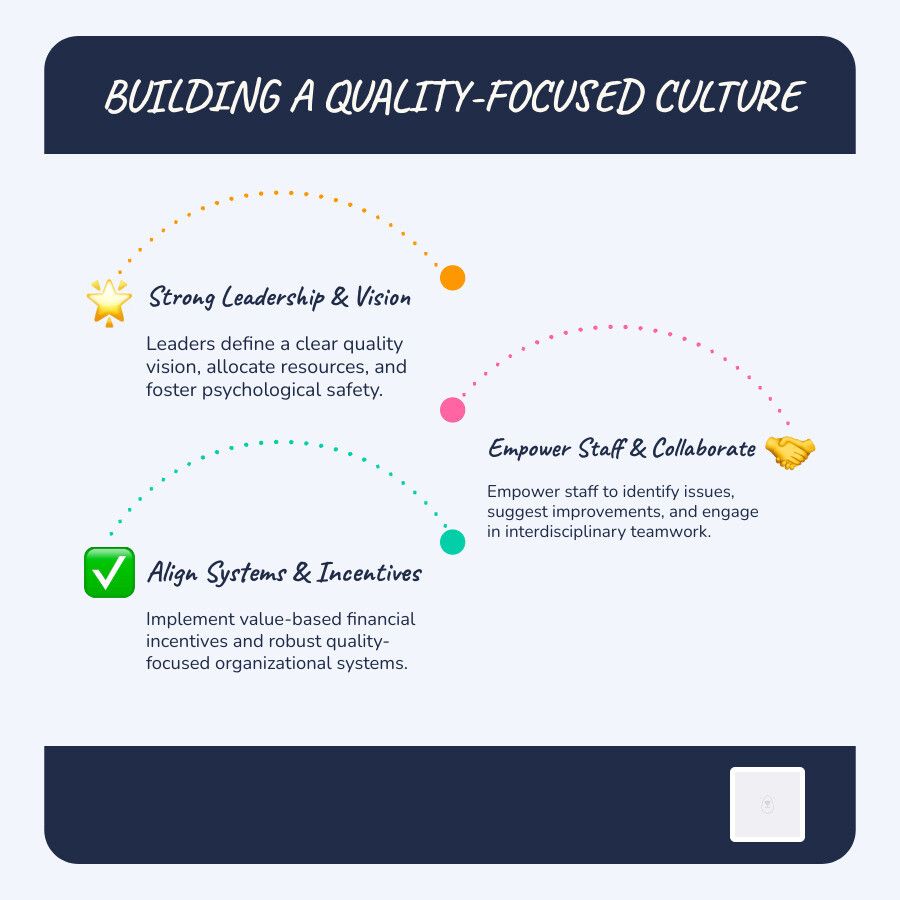The Foundation: Evidence-Based Practice and Continuous Quality Improvement
A dual commitment to Evidence-Based Practice (EBP) and Continuous Quality Improvement (CQI) is at the heart of any successful effort to improve healthcare outcomes. These two pillars provide the framework for delivering effective and constantly evolving care. EBP ensures that the best available research informs clinical decisions, while CQI offers a systematic approach to refining processes and improving patient outcomes over time.

The journey of quality improvement often begins with structured methodologies. One of the most widely recognized is the Plan-Do-Study-Act (PDSA) cycle. This iterative, four-phase model allows healthcare teams to test changes on a small scale, learn from the results, and then implement or refine the changes. Alongside PDSA, tools like Root Cause Analysis (RCA) are crucial for delving into adverse events or near misses to identify underlying systemic issues rather than individual blame. RCA helps us understand why something went wrong, enabling us to design more robust processes.
While the principles of EBP and CQI are sound, their implementation in complex healthcare environments presents challenges and facilitators. Challenges often include resistance to change, lack of resources (time, money, staff), insufficient training, and data collection and analysis difficulties. However, facilitators such as strong leadership support, engaged multidisciplinary teams, a culture of learning, and clear communication can significantly improve success. It’s important to acknowledge that CQI interventions can sometimes show mixed results, with less than half of Randomized Controlled Trials (RCTs) demonstrating a significant effect on clinical process or patient outcomes. For instance, 54.2% of RCTs reported no statistically significant difference in clinical process measures between CQI and non-CQI interventions, and 64.7% reported no statistically significant difference in patient outcomes. This highlights the complexity of healthcare systems and the need for rigorous, context-specific evaluation.
The Role of Evidence-Based Practice (EBP)
EBP is more than just following guidelines; it’s a dynamic process that involves integrating the best research evidence with clinical expertise and patient values and preferences. This holistic approach ensures that care is not only scientifically sound but also custom to each patient’s individual needs and choices. When healthcare professionals engage in shared decision-making, they empower patients to participate actively in their care journey, leading to greater satisfaction and adherence to treatment plans.
The push for EBP is driven by a fundamental need to bridge the gap between what we know works and what is actually done in practice. As highlighted in the seminal report “Crossing the Quality Chasm,” there’s a persistent disparity between the care patients should receive and what they often receive. Embracing EBP is a critical step towards closing this gap.
Furthermore, the adoption of EBP is often directly linked to financial incentives. Most implemented EBPs (90%) are connected to reimbursement, underscoring the economic imperative for quality care. While only 19% of studies explicitly measured Return on Investment (ROI) for EBP implementation, a remarkable 94% of those that did showed a positive ROI, with none showing a negative ROI. This demonstrates that investing in evidence-based care benefits patients and provides tangible financial returns for healthcare systems.
Implementing and Sustaining CQI Initiatives
Effective implementation and long-term sustainability of CQI initiatives require a concerted effort from all stakeholders. Leadership plays a pivotal role, setting the vision, allocating necessary resources, and championing a culture of continuous improvement. Their visible commitment and active participation are essential to overcoming inertia and fostering organizational buy-in.
Clinician engagement is equally vital. Frontline staff possess invaluable insights into daily processes and potential areas for improvement. Empowering them to identify problems, propose solutions, and participate in improvement teams ensures that changes are practical and sustainable. Regular audit and feedback loops are crucial for monitoring progress, identifying deviations, and making necessary adjustments. This data-driven approach keeps initiatives on track and allows for timely course correction.
Organizations must integrate CQI into their operational DNA to sustain momentum, making it a routine part of how care is delivered and improved. Resources like those from the Agency for Healthcare Research and Quality (AHRQ) provide valuable guidance and tools for healthcare organizations committed to enhancing quality and safety. By embedding CQI principles, healthcare systems can foster an environment where improvement is not a temporary project but an ongoing commitment.
Key Strategies for Improving Healthcare Outcomes
Beyond the foundational elements of EBP and CQI, several key strategies directly influence patient well-being and satisfaction. These encompass fostering a strong patient safety culture, emphasizing preventive medicine, optimizing provider-patient communication, and implementing robust inpatient safety protocols. Each area contributes significantly to a holistic approach to improving healthcare outcomes.

Optimizing Communication for Better Engagement
Effective communication is the cornerstone of patient-centered care. It goes beyond simply conveying information; it involves ensuring health literacy, providing clear patient education, and demonstrating empathy in every interaction. When patients fully understand their condition, treatment options, and care plans, they are more likely to adhere to recommendations and achieve better results.
Digital communication tools, such as patient portals, secure messaging, and telehealth platforms, offer new avenues for engagement. These tools can facilitate ongoing dialogue, provide access to educational resources, and allow patients to manage their health information actively.
Here are some effective patient communication techniques:
- Active Listening: Fully concentrate on what the patient is saying verbally and non-verbally.
- Plain Language: Avoid medical jargon; explain complex concepts in simple, understandable terms.
- Teach-Back Method: Ask patients to explain in their own words what they’ve learned to ensure comprehension.
- Empathy and Validation: Acknowledge and validate patients’ feelings and concerns.
- Shared Decision-Making: Involve patients in decisions about their care, respecting their values and preferences.
- Clear Instructions: Provide written medication instructions, follow-up appointments, and warning signs.
- Digital Engagement: Use secure messaging and patient portals for convenient and consistent communication.
The Impact of Preventive Care Strategies
Preventive care is a powerful, often undervalued, strategy for improving healthcare outcomes and reducing healthcare costs. By preventing illness rather than treating it, we can significantly improve population health and reduce the burden on acute care services.
Primary prevention initiatives, such as health screenings (e.g., for cancer, diabetes, and hypertension), immunization programs, and lifestyle counseling (e.g., nutrition, exercise, and smoking cessation), aim to prevent diseases before they start. Effective chronic disease management programs help individuals with existing conditions avoid complications and maintain a higher quality of life.
The cost-effectiveness of prevention is undeniable. Investing in preventive care can avert more expensive treatments, reduce hospitalizations, and improve productivity. For example, robust immunization programs prevent outbreaks, and early detection through screenings can lead to less invasive and more successful treatments for diseases like cancer. This proactive approach is a critical component of a sustainable healthcare system.
Essential Inpatient Safety Practices
Patient safety is paramount in any healthcare setting, particularly within hospitals. Unsafe care can lead to adverse health outcomes and even be a leading cause of death. Therefore, implementing and rigorously adhering to essential inpatient safety practices is non-negotiable.
One central area of focus is preventing Healthcare-Associated Infections (HAIs). These infections, acquired during hospital stays, can lead to prolonged hospitalizations, increased costs, and higher mortality rates. Strict hand hygiene, environmental cleaning, and sterile techniques are fundamental. The Centers for Disease Control and Prevention (CDC) provides regular data on HAI progress, highlighting ongoing efforts and improvement areas.
Other critical safety practices include:
- Medication Reconciliation: A process of comparing a patient’s current medication list with new medications to identify and resolve discrepancies, significantly reducing medication errors.
- Fall Prevention Programs: Implementing protocols like patient risk assessments, bed alarms, and clear pathways to reduce the incidence of patient falls within the facility.
- Surgical Safety Checklists: Standardized checklists, similar to those used in aviation, ensure that critical steps are not missed before, during, and after surgical procedures, improving patient outcomes and reducing complications.
When consistently applied, these practices create a safer environment for patients and contribute directly to better clinical results.
Leveraging Technology and Data to Drive Better Outcomes
In the modern healthcare landscape, technology and data analytics are no longer optional but indispensable tools for improving healthcare outcomes. They provide the insights needed to make informed decisions, streamline processes, and personalize patient care. The field of health informatics is rapidly expanding, focusing on how information technology can be used to acquire, store, retrieve, and use healthcare data effectively.

The shift towards data-driven decision-making allows healthcare organizations to move from reactive responses to proactive strategies. Electronic Health Records (EHRs) form the backbone of this data ecosystem, consolidating patient information and making it accessible to care teams. Beyond basic record-keeping, advanced tools like predictive analytics can forecast patient risks, identify potential complications, and optimize resource allocation, leading to more efficient and effective interventions.
Using Data to Monitor and Analyze Performance
Effective outcome improvement hinges on the ability to measure and analyze performance accurately. This involves tracking various Key Performance Indicators (KPIs), which can be categorized into outcome measures (what happened to the patient’s health) and process measures (how care was delivered).
Patient-Reported Outcomes Measures (PROMs) are gaining increasing importance as they capture the patient’s perspective on their health status and quality of life, offering invaluable insights that traditional clinical metrics might miss. For instance, while the length of stay (15% of studies) and mortality (12% of studies) are commonly reported outcomes, PROMs provide a more nuanced understanding of the patient experience. By systematically collecting and analyzing this data, healthcare providers can identify trends, benchmark performance against best practices, and pinpoint areas for targeted interventions.
Innovative Technologies in Modern Healthcare
The rapid advancement of technology is continually opening new frontiers for improving healthcare outcomes. Telehealth services have revolutionized access to care, enabling remote consultations, monitoring, and even therapy, which is particularly beneficial for patients in rural areas or those with mobility challenges. Remote patient monitoring allows clinicians to track vital signs, glucose levels, and other health data from a distance, enabling early intervention and reducing the need for hospital visits.
Wearable health devices empower individuals to take a more active role in managing their health, providing real-time data that can be shared with their care providers. Furthermore, the integration of artificial intelligence in diagnostics is enhancing the accuracy and speed of disease detection, from analyzing medical images to identifying patterns in complex patient data. These innovations and advanced therapeutic technologies that support recovery and well-being are changing how we deliver care and accelerate healing processes. For example, our advanced healing solutions leverage the science of cellular regeneration to address issues like inflammation and accelerate the wound healing process, making post-surgical recovery easier and offering benefits for conditions like Parkinson’s. These technologies are at the forefront of improving healthcare outcomes with far infrared therapy for pain relief and overall patient well-being. Gladiator Therapeutics’ healing devices help reduce long recovery times and provide advanced healing solutions.
Building a Culture for Improving Healthcare Outcomes
The most significant driver of sustained improvement in healthcare outcomes is the cultivation of a robust organizational culture that prioritizes quality and safety. This culture is characterized by strong leadership commitment, staff empowerment, and appropriate financial incentives that align with value-based care principles.

Leadership’s Responsibility in Driving Change
Healthcare leaders are profoundly responsible for driving the necessary changes to improve outcomes. This begins with setting a clear vision for quality and safety that permeates every level of the organization. Leaders must ensure adequate resource allocation and provide the tools, training, and personnel required for improvement initiatives.
Crucially, leaders must foster an environment of psychological safety, where staff feel comfortable speaking up about concerns, reporting errors, and suggesting improvements without fear of reprisal. This openness is vital for learning and continuous growth. Promoting interdisciplinary collaboration ensures that diverse perspectives are brought to bear on complex problems, leading to more comprehensive solutions. Programs like the Magnet Recognition Program exemplify how organizations can achieve excellence in nursing and patient care through strong leadership and a quality culture.
The Financial Case for Quality: A Driver for Improving Healthcare Outcomes
Pursuing quality in healthcare is not just a moral imperative; it’s a sound business strategy. The shift towards value-based purchasing models means that healthcare providers are increasingly reimbursed based on the quality of care they deliver and the outcomes they achieve, rather than simply the volume of services. This creates a powerful financial incentive to invest in improvement.
The Return on Investment (ROI) for quality initiatives can be substantial. As noted earlier, 94% of studies that measured ROI for EBP implementation showed a positive return. This is because improving quality reduces the Cost of Poor Quality (COPQ), which includes expenses related to medical errors, readmissions, complications, and patient dissatisfaction. By reducing HAIs, preventing falls, and optimizing treatment pathways, healthcare organizations can significantly lower their operating costs while simultaneously enhancing patient well-being. The financial benefits reinforce the commitment to continuous improvement, creating a virtuous cycle where better care leads to better financial health, and vice versa.
Frequently Asked Questions about Improving Patient Outcomes
What is the difference between quality improvement and clinical research?
The distinction between quality improvement (QI) and clinical research can sometimes be blurred, but their fundamental goals and methodologies differ. QI focuses on improving local systems and processes within a healthcare setting to improve patient care. It often uses rapid, iterative cycles (like PDSA) to test changes and is primarily concerned with immediate, practical improvements. In contrast, clinical research aims to generate new, generalizable knowledge that can be applied broadly beyond the specific study setting. It follows a strict, predefined protocol, often involves control groups, and seeks to prove hypotheses with statistical significance. While QI usually uses data, its primary purpose is not to contribute to theoretical knowledge but to improve current practice.
How are healthcare outcomes typically measured?
Healthcare outcomes are measured through various metrics to capture a comprehensive picture of patient health and care effectiveness. These include:
- Clinical metrics: Objective measures such as mortality rates, readmission rates, infection rates (e.g., HAIs), complication rates, and disease-specific indicators (e.g., A1C levels for diabetes, blood pressure control).
- Patient-Reported Outcome Measures (PROMs): Subjective assessments directly from patients about their health status, functional abilities, quality of life, and symptoms.
- Functional status: Measures related to a patient’s ability to perform daily activities.
- Patient satisfaction scores: Patients’ feedback regarding their care experience, communication, and overall hospital stay.
- Cost and resource utilization: Metrics related to healthcare expenditures, length of hospital stay, and use of resources, indicating efficiency.
What is the first step a healthcare facility can take to improve its outcomes?
The first step a healthcare facility can take to improve its outcomes is forming a multidisciplinary quality improvement team. This team should include representatives from various departments and levels of staff, including clinicians, nurses, administrators, and support staff. Once formed, the team should identify a specific, measurable problem or area for improvement (e.g., reducing readmissions for a particular condition, lowering infection rates in a specific unit). They should then collect baseline data related to this problem to understand its current state and establish a benchmark against which to measure future changes. Finally, they can use a structured methodology like the PDSA cycle to plan, implement, and evaluate small, incremental changes.
Conclusion
The journey towards improving healthcare outcomes is a continuous, multifaceted endeavor that demands dedication, innovation, and a patient-centered approach. We have explored the critical foundations of Evidence-Based Practice and Continuous Quality Improvement, recognizing their indispensable role in shaping effective and evolving care. We’ve dug into key strategies, from optimizing communication and championing preventive care to implementing rigorous inpatient safety protocols. The transformative power of technology and data analytics, enabling precise monitoring, informed decision-making, and deploying advanced therapeutic solutions, is undeniable.
A deep commitment to the patient drives this paradigm shift from volume-based to value-based care. It’s about ensuring that every interaction, every treatment, and every system contributes to the best possible health outcomes and a positive patient experience. By fostering a culture of quality, empowering our healthcare professionals, and leveraging the full potential of innovation, we can collectively advance the standard of care. This continuous journey of improvement is not just about achieving metrics; it’s about enhancing human lives and truly making a difference in the health and well-being of our communities.
Throughout the year, our writers feature fresh, in-depth, and relevant information for our audience of 40,000+ healthcare leaders and professionals. As a healthcare business publication, we cover and cherish our relationship with the entire health care industry including administrators, nurses, physicians, physical therapists, pharmacists, and more. We cover a broad spectrum from hospitals to medical offices to outpatient services to eye surgery centers to university settings. We focus on rehabilitation, nursing homes, home care, hospice as well as men’s health, women’s heath, and pediatrics.
Disclaimer: The content on this site is for general informational purposes only and is not intended as medical, legal, or financial advice. No content published here should be construed as a substitute for professional advice, diagnosis, or treatment. Always consult with a qualified healthcare or legal professional regarding your specific needs.
See our full disclaimer for more details.







